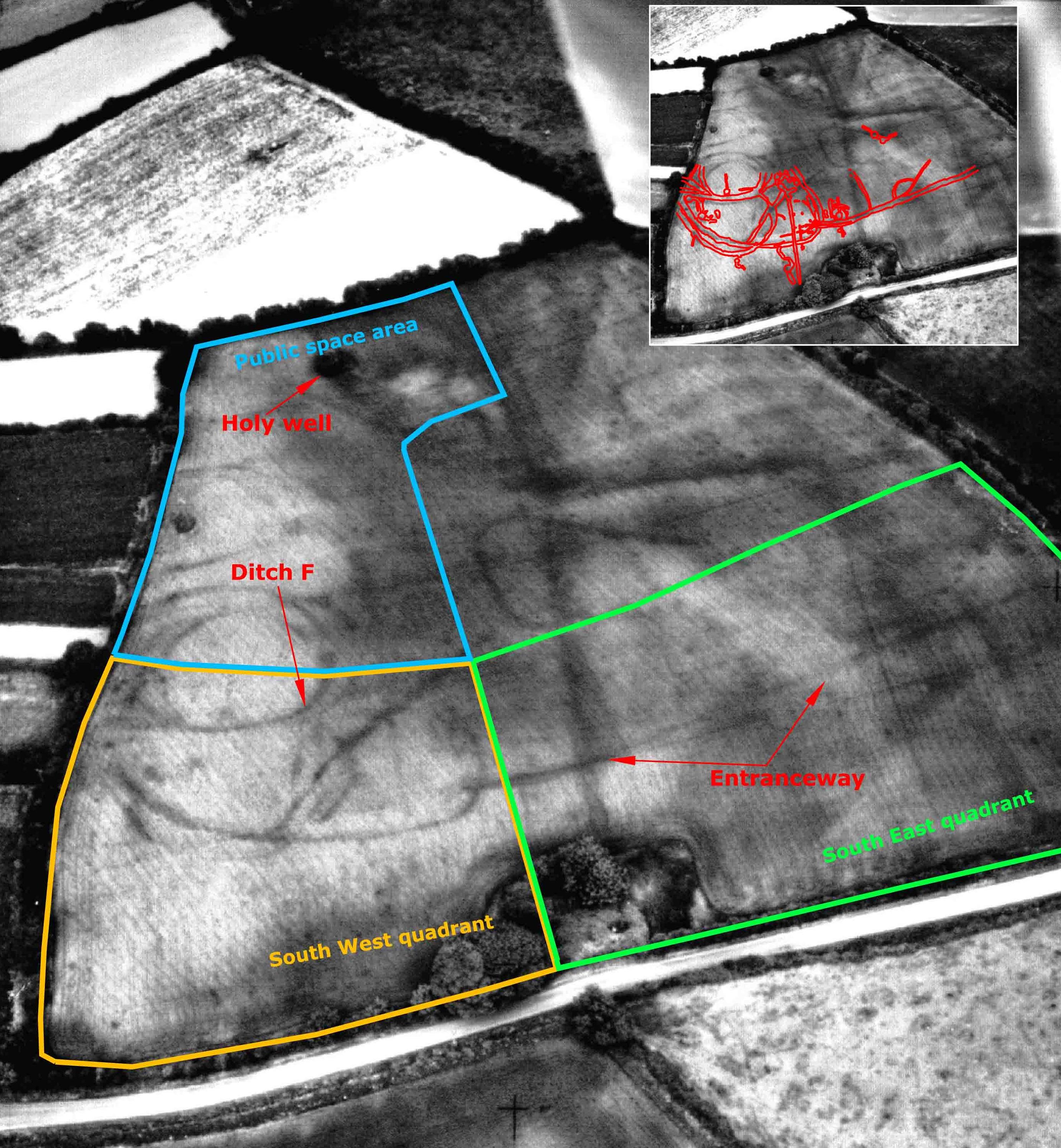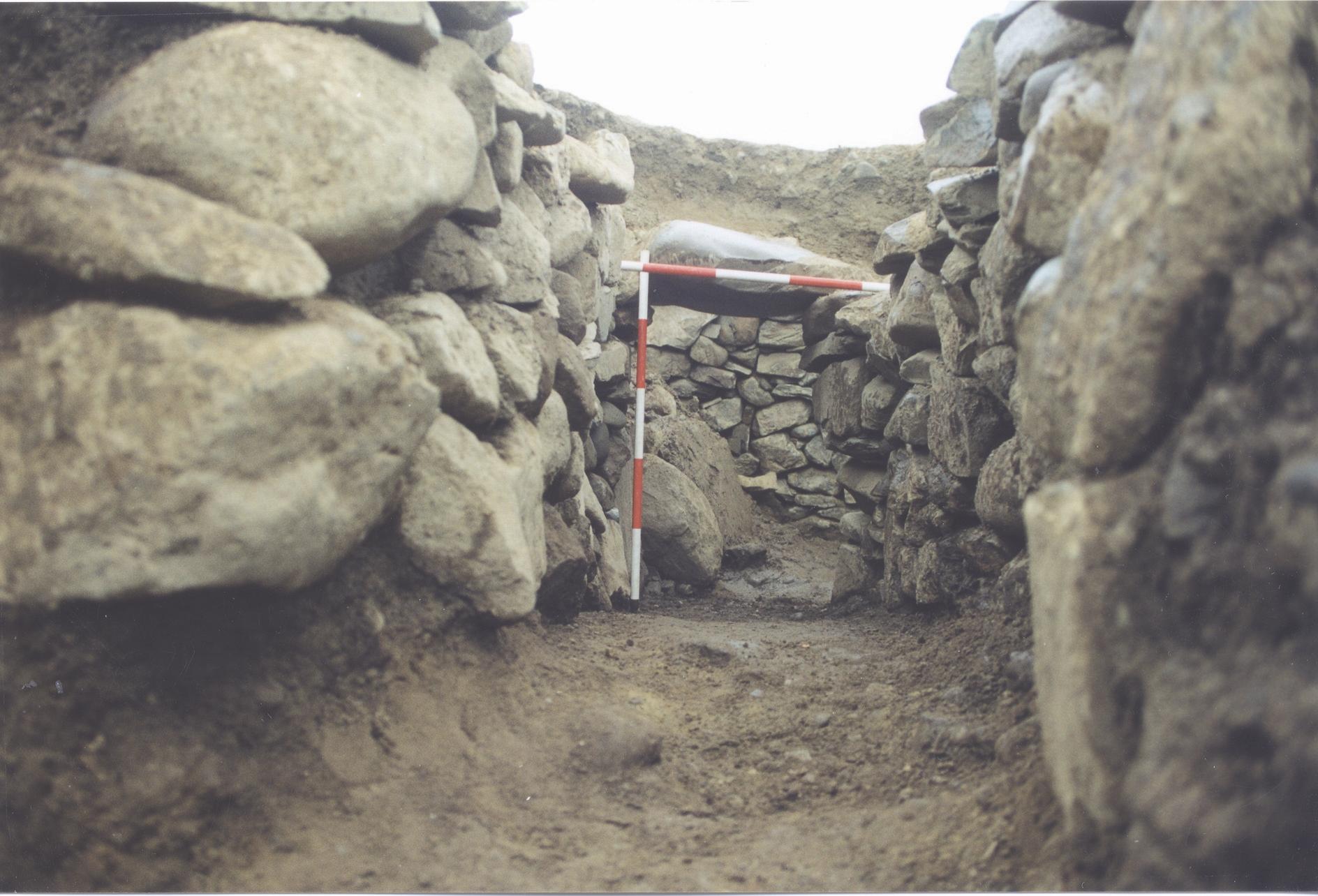Heritage by Area - Balrothery
The mound at Inch and the standing stone had indicated the presence of people in Balrothery during the Bronze age(2400-500BC). However excavations by Ken Wiggins in advance of the development of the Balruddery Fields and Ringfort housing estates, uncovered a funerary landscape including ring-ditches and cremation cemeteries dating from the mid to late Bronze Age.
Early medieval Balrothery
Across the road at Rosepark significant excavations by Judith Carroll showed that the hilltop had been defended by ditch fortifications during from the Iron Age becoming an important settlement, until it fell out of use in the 9th century AD.

During this period Ireland was a hierarchical and kin orientated society. Balrothery was part of Brega, a territory which encompassed most of Meath, south Louth and north Dublin, but at a local level was ruled by indigenous and often warring groups such as the Saithne. The inhabitants appear to have been herding cattle and sheep and farming crops such as barley. Much of these early medieval remains are preserved within the open space of Rosepark.
Souterrains
Seven souterrains-underground chambers and passages-were excavated at Rosepark. Before their excavation just four were known in the entirety of Co. Dublin. It is likely that souterrains had several functions including storage of goods. Given their size and that some of the souterrains have air-vents, it is suggested that those at Rosepark were used by people, although whether they were for slaves, hostages or hiding members of the community from raids is unknown.

Vikings
A rich well-established site such as Rosepark would undoubtedly attract raids from opposing kin groups as well as further afield. While no direct evidence has thus far been uncovered, historically it is recorded that Ragnailt the daughter of Olaf, Viking king of Dublin inherited the lands of Balrothery as her marriage portion indicating the Vikings had taken control of Balrothery, their raids possibly determining why there was a need for so many souterrains.
Medieval Balrothery
The Anglo-Norman ally of Strongbow, Robert de Rosel was granted Balrothery in c.1171 ‘where he built the town and castle’. His son Patrick became the parson of the church in Balrothery and after his death Geoffrey de Costedin donated lands at Balrothery to Tristernagh Abbey, Kilbixy, Co. Westmeath between 1191 and 1212. The medieval church was levelled in the early nineteenth century. It was described in the previous century by Austin Cooper as ‘an old Church of extraordinary construction..much mutilated..it formerly consisted of a range of arched recesses..’. The western residential tower survives and has been compared to that at Lusk. Both towers have been dated to the fifteenth century.
The graveyard contains a significant group of eighteenth century inscribed gravestones as well as a reused millstone. Test excavations undertaken to the south of the church by Donald Murphy in 1999 showed that the burials extended beyond the current limits of the graveyard. A three storey towerhouse is located on private land south of the church and graveyard.
Post-Medieval Balrothery
Located on the Old Coach road which is thought to form part of the Slighe Mhidhuachra, one of the five ancient roads which led from Tara, Balrothery was a hive of activity. Industries included two distilleries, a biscuit factory, a tannery, chair-making factory and weaving as a local cottage industry. Austin Cooper visited described the town in June 1783 as ‘a small village about 14 miles from Dublin on the Great North road which circumstance is the only thing that preserves it. It has always reckoned famous for one extra-ordinary perfection-making cakes’. Cooper wasn’t wrong. When the turnpike and subsequently the post-mail coaches were diverted to Balbriggan, the importance of Balrothery began to fade.
Folkore
Tall tales can often have a kernel of truth in them especially when they grow up around placenames- ancient skeletons have been actually been found in fields known as the Bone field and long forgotten settlements in Old-towns. There is a tradition that James II lodged in the White Hart inn, Balrothery on his way to the Battle of the Boyne.
Did you know
That the early medieval inhabitants of Rosepark were fond of a drink? Archaeological evidence revealed they were malting barley for brewing beer and importing wine from western France.
Did you know
That according to the census of 1659 there were 68 inhabitants in Balrothery compared to 30 in Balbriggan and 56 in Skerries?
Did you know
That the Bronze Age pots containing cremated remains excavated at Darcystown had been used for cooking beforehand?
Did you know
That burials at St Peter’s church extend beyond the graveyard wall? Excavations have revealed a large ditch and burials which may predate the medieval church and graveyard.
Find out more
Fingal Local Studies Library, Clonmel House, Forster Way, Swords. [email protected]
Balbriggan Library, George’s Square, Balbriggan [email protected]
Baker, C. 2010, Antiquities of old Fingal; the archaeology of north County Dublin. Wordwell. Dublin.
Carroll, J. 2008, Archaeological Excavations at Rosepark, Balrothery, Co. Dublin. Balrothery excavations Vol. 1
Carroll, J., Ryan, F & Wiggins, K. 2008, Archaeological Excavations at Glebe South and Darcystown, Balrothery, Co. Dublin. Balrothery excavations Vol. 2